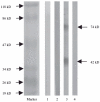Cross-reaction of anti-DNA autoantibodies with membrane proteins of human glomerular mesangial cells in sera from patients with lupus nephritis
- PMID: 16792669
- PMCID: PMC1942001
- DOI: 10.1111/j.1365-2249.2006.03102.x
Cross-reaction of anti-DNA autoantibodies with membrane proteins of human glomerular mesangial cells in sera from patients with lupus nephritis
Abstract
Anti-DNA autoantibodies were thought to play a major role in the pathogenesis of lupus nephritis (LN). A recent study revealed that affinity-purified anti-DNA antibodies had a cross-reaction with human glomerular mesangial cells (HMC). However, whether the cross-reaction was antigen-antibody-mediated was unclear. The aim of the current study was to investigate the binding of anti-DNA antibodies to HMC membrane proteins and to characterize the target antigens. Affinity-purified IgG anti-DNA antibodies were purified by DNA-cellulose chromatography in sera from nine patients with biopsy-proven active lupus nephritis. In vitro cultured primary HMCs were disrupted by sonication and HMC membranes were obtained by differential centrifugation. The membranes of human umbilical vein endothelial cells (HUVEC), human proximal renal tubular epithelial cell line (HK2) and peripheral mononuclear cells (PMC) were obtained as controls. Binding of anti-DNA antibodies to the membrane proteins was investigated by Western blot analysis using soluble membrane proteins as antigens. Both HMC membrane and affinity-purified anti-DNA antibodies were treated with DNase I to exclude DNA bridging. All nine affinity-purified anti-DNA antibodies could blot the HMC membrane proteins, and there were at least three bands at 74 kDa, 63 kDa and 42 kDa that could be blotted. Among the nine IgG preparations, all nine (100%) could blot the 74 kDa band; eight (88.9%) could recognize 63 kDa and 42 kDa protein bands separately. After DNase treatment, the same bands could still be blotted by most affinity-purified anti-DNA antibodies. Affinity-purified anti-DNA antibodies could also blot similar bands on membrane proteins of other cells, but some bands were different. In conclusion, anti-DNA autoantibodies could cross-react directly with cell membrane proteins of human glomerular mesangial cells and might play an important role in the pathogenetic mechanism in lupus nephritis.
Figures




Similar articles
-
Characterization of anti-mesangial cell antibodies and their target antigens in patients with lupus nephritis.J Clin Immunol. 2005 May;25(3):281-7. doi: 10.1007/s10875-005-4082-6. J Clin Immunol. 2005. PMID: 15981094
-
[Characterization of target antigens of the novel anti-mesangial cell antibodies in sera from patients with lupus nephritis].Zhonghua Yi Xue Za Zhi. 2004 Feb 2;84(3):194-8. Zhonghua Yi Xue Za Zhi. 2004. PMID: 15059533 Chinese.
-
Non-DNA-binding antibodies in patients with lupus nephritis could recognize membrane proteins of glomerular mesangial cells.J Clin Immunol. 2006 Mar;26(2):138-44. doi: 10.1007/s10875-006-9004-8. Epub 2006 Apr 18. J Clin Immunol. 2006. PMID: 16619136
-
Anti-DNA antibodies in the pathogenesis of lupus nephritis--the emerging mechanisms.Autoimmun Rev. 2008 Feb;7(4):317-21. doi: 10.1016/j.autrev.2007.12.001. Epub 2007 Dec 26. Autoimmun Rev. 2008. PMID: 18295737 Review.
-
Autoimmunity against nucleosomes and lupus nephritis.Ann Med Interne (Paris). 1996;147(7):485-9. Ann Med Interne (Paris). 1996. PMID: 9092359 Review.
Cited by
-
Glomerular antibodies in lupus nephritis.Clin Rev Allergy Immunol. 2011 Jun;40(3):151-8. doi: 10.1007/s12016-010-8204-4. Clin Rev Allergy Immunol. 2011. PMID: 20414746 Review.
-
Clearing the complexity: immune complexes and their treatment in lupus nephritis.Int J Nephrol Renovasc Dis. 2011;4:17-28. doi: 10.2147/IJNRD.S10233. Epub 2011 Jan 11. Int J Nephrol Renovasc Dis. 2011. PMID: 21694945 Free PMC article.
-
Mesangial cell-specific antibodies are central to the pathogenesis of lupus nephritis.Clin Dev Immunol. 2012;2012:579670. doi: 10.1155/2012/579670. Epub 2011 Nov 28. Clin Dev Immunol. 2012. PMID: 22162716 Free PMC article. Review.
-
Emerging concepts and treatments in autoinflammatory interferonopathies and monogenic systemic lupus erythematosus.Nat Rev Rheumatol. 2025 Jan;21(1):22-45. doi: 10.1038/s41584-024-01184-8. Epub 2024 Dec 2. Nat Rev Rheumatol. 2025. PMID: 39623155 Review.
-
Association of Autoantibody Concentrations and Trajectories With Lupus Nephritis Histologic Features and Treatment Response.Arthritis Rheumatol. 2024 Nov;76(11):1611-1622. doi: 10.1002/art.42941. Epub 2024 Aug 9. Arthritis Rheumatol. 2024. PMID: 38962936
References
-
- Hahn BH. Antibodies to DNA. N Engl J Med. 1998;338:1359–68. - PubMed
-
- Lefkowith JB, Gilkeson GS. Nephritogenic autoantibodies in lupus: current concepts and continuing controversies. Arthritis Rheum. 1996;39:894–903. - PubMed
-
- Deocharan B, Qing X, Beger E, Putterman C. The antigenic triggers and molecular targets for anti-double stranded DNA antibodies. Lupus. 2002;11:865–71. - PubMed
Publication types
MeSH terms
Substances
LinkOut - more resources
Full Text Sources

